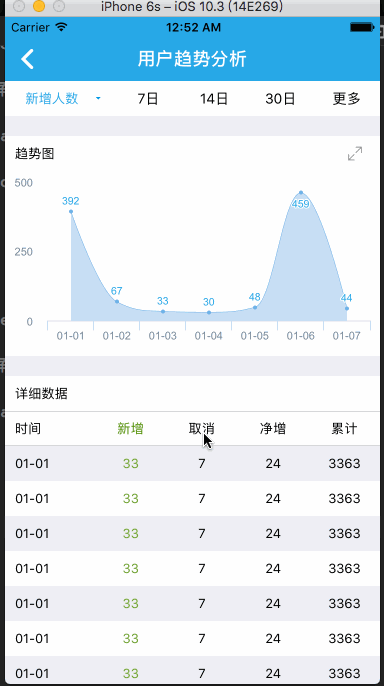原文链接 https://www.jianshu.com/p/d6cb54d2eaa1
亲测第二种我这边是阔以滴
第一种解决方案(不推荐,直接跳过看第二种解决方案):
//强制转屏
- (void)interfaceOrientation:(UIInterfaceOrientation)orientation
{
if ([[UIDevice currentDevice] respondsToSelector:@selector(setOrientation:)]) {
SEL selector = NSSelectorFromString(@"setOrientation:");
NSInvocation *invocation = [NSInvocation invocationWithMethodSignature:[UIDevice instanceMethodSignatureForSelector:selector]];
[invocation setSelector:selector];
[invocation setTarget:[UIDevice currentDevice]];
int val = orientation;
// 从2开始是因为0 1 两个参数已经被selector和target占用
[invocation setArgument:&val atIndex:2];
[invocation invoke];
}
}
强制横屏:
[self interfaceOrientation:UIInterfaceOrientationLandscapeRight];
强制竖屏:
[self interfaceOrientation:UIInterfaceOrientationPortrait];
只在某一个界面提供转屏的解决方法如下AppDelegate.m下操作
-(UIInterfaceOrientationMask)application:(UIApplication *)application supportedInterfaceOrientationsForWindow:(UIWindow *)window {
NSLog(@"0000000---------%@",NSStringFromClass([[self topViewController] class]));
if ([NSStringFromClass([[self topViewController] class]) isEqualToString:@"想要提供转屏的控制器的名字"]) {
//横屏
return UIInterfaceOrientationMaskLandscapeRight;
}
//竖屏
return UIInterfaceOrientationMaskPortrait;
}
//获取界面最上层的控制器
- (UIViewController*)topViewController {
return [self topViewControllerWithRootViewController:[UIApplication sharedApplication].keyWindow.rootViewController];
}
//一层一层的进行查找判断
- (UIViewController*)topViewControllerWithRootViewController:(UIViewController*)rootViewController {
if ([rootViewController isKindOfClass:[UITabBarController class]]) {
UITabBarController* tabBarController = (UITabBarController*)rootViewController;
return [self topViewControllerWithRootViewController:tabBarController.selectedViewController];
} else if ([rootViewController isKindOfClass:[UINavigationController class]]) {
UINavigationController* nav = (UINavigationController*)rootViewController;
return [self topViewControllerWithRootViewController:nav.visibleViewController];
} else if (rootViewController.presentedViewController) {
UIViewController* presentedViewController = rootViewController.presentedViewController;
return [self topViewControllerWithRootViewController:presentedViewController];
} else {
return rootViewController;
}
}
如果你的应用的根控制器是Nav就把下面这段代码放到Nav根控制器下,如果是TabVC放到TabVC的下面
- (BOOL)shouldAutorotate{
return YES;
}
- (UIInterfaceOrientationMask)supportedInterfaceOrientations{
return UIInterfaceOrientationMaskPortrait;
}
然后在你想横屏的控制器加上这段代码,基本上横屏问题就可以搞定了,前提是你的这个控制器是moda出来的,如果是push的话就要使用上文提到的强制横竖屏的方法,下面这段代码是不起作用的
- (BOOL) shouldAutorotateToInterfaceOrientation:(UIInterfaceOrientation)toInterfaceOrientation {
return (toInterfaceOrientation == UIInterfaceOrientationLandscapeRight);
}
- (UIInterfaceOrientationMask)supportedInterfaceOrientations {
return UIInterfaceOrientationMaskLandscapeRight;
}
第二种解决方案:
灵活设置横竖屏,不用区分Push还是Present,都是可以设置。
第一步:
在AppDelegate.h中添加旋转属性
/**
* 是否允许转向
*/
@property(nonatomic,assign)BOOL allowRotation;
在AppDelegate.m中添加转屏的代理方法
- (UIInterfaceOrientationMask)application:(UIApplication *)application supportedInterfaceOrientationsForWindow:(nullable UIWindow *)window
{
if (self.allowRotation == YES) {
//横屏
return UIInterfaceOrientationMaskLandscape;
}else{
//竖屏
return UIInterfaceOrientationMaskPortrait;
}
}
第二步:
设置横竖屏的核心方法,我是直接把这个方法添加到了UIDevice的分类中,代码如下:
- UIDevice+TFDevice.h :
#import <UIKit/UIKit.h>
@interface UIDevice (TFDevice)
/**
* @interfaceOrientation 输入要强制转屏的方向
*/
+ (void)switchNewOrientation:(UIInterfaceOrientation)interfaceOrientation;
@end
- UIDevice+TFDevice.m :
#import "UIDevice+TFDevice.h"
@implementation UIDevice (TFDevice)
+ (void)switchNewOrientation:(UIInterfaceOrientation)interfaceOrientation
{
NSNumber *resetOrientationTarget = [NSNumber numberWithInt:UIInterfaceOrientationUnknown];
[[UIDevice currentDevice] setValue:resetOrientationTarget forKey:@"orientation"];
NSNumber *orientationTarget = [NSNumber numberWithInt:interfaceOrientation];
[[UIDevice currentDevice] setValue:orientationTarget forKey:@"orientation"];
}
@end
第三步:
在需要设置横屏的控制器的ViewDidLoad中添加下面代码:
- (void)viewDidLoad {
[super viewDidLoad];
AppDelegate * appDelegate = (AppDelegate *)[UIApplication sharedApplication].delegate;
//允许转成横屏
appDelegate.allowRotation = YES;
//调用横屏代码
[UIDevice switchNewOrientation:UIInterfaceOrientationLandscapeRight];
}
第四步 (针对Push出的控制器来说):
需要注意的是push过去的时候变成横屏,pop出去的时候在设置竖屏,此时最好禁用系统的侧滑返回手势。
-(void)viewWillAppear:(BOOL)animated{
[super viewWillAppear:animated];
//禁用侧滑手势方法
self.navigationController.interactivePopGestureRecognizer.enabled = NO;
}
-(void)viewWillDisappear:(BOOL)animated{
[super viewWillDisappear:animated];
//禁用侧滑手势方法
self.navigationController.interactivePopGestureRecognizer.enabled = YES;
}
第五步:
push控制器:
//点击导航栏返回按钮的时候调用,所以Push出的控制器最好禁用侧滑手势:
AppDelegate * appDelegate = (AppDelegate *)[UIApplication sharedApplication].delegate;
appDelegate.allowRotation = NO;//关闭横屏仅允许竖屏
//切换到竖屏
[UIDevice switchNewOrientation:UIInterfaceOrientationPortrait];
[self.navigationController popViewControllerAnimated:YES];
present控制器:
AppDelegate * appDelegate = (AppDelegate *)[UIApplication sharedApplication].delegate;
appDelegate.allowRotation = NO;//关闭横屏仅允许竖屏
//切换到竖屏
[UIDevice switchNewOrientation:UIInterfaceOrientationPortrait];
[self dismissViewControllerAnimated:YES completion:nil];
第六步: 上图
